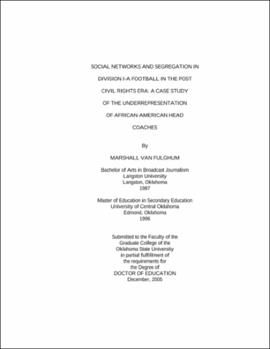| dc.contributor.advisor | Hyle, Adrienne E. | |
| dc.contributor.author | Fulghum, Marshall Van | |
| dc.date.accessioned | 2013-11-26T08:34:58Z | |
| dc.date.available | 2013-11-26T08:34:58Z | |
| dc.date.issued | 2005-12 | |
| dc.identifier.uri | https://hdl.handle.net/11244/7604 | |
| dc.description.abstract | Scope and Method of Study: The purpose of this study is to examine whether there have been any changes in the number of African-American head coaches in Division I-A institutions since the enactment of the Civil Rights Act of 1964 and to identify the factors that influence selection as head coaches in Division I-A football programs. Perpetuation Theory would explain the disproportionate overrepresentation of white coaches in an arena populated equally by black athletes (Braddock, 1980) in terms of the underdevelopment of networks or ties designed to foster links between minority groups and dominant majority groups (Wells & Crain, 1994). These links between student-athletes and essential knowledge and opportunities needed to access information networks and ties regarding head football coaching positions at Division I-A colleges and universities (Granovetter, 1973) may be missing or underdeveloped, thus explaining these demographics. | |
| dc.description.abstract | In order to answer questions about the factors that influence selection, biographies were obtained for each of the Division I-A coaches in each of the respective years being studied (349 total). The collection and assessment of empirical data in 20-year increments provided a snapshot of the demographic population for all Division I-A head football coaches studied. Overall trends were examined with respect to the number of African-American head football coaches in the years studied and all coaches' football playing and coaching experience, including length of time and key positions. | |
| dc.description.abstract | Findings and Conclusions: Racial segregation still exists in Division I-A collegiate football, with regard to selection for head coaching positions. The primary factors affecting selection as a head coach are collegiate football playing experience and positions played. Further, selection as a head coach was also influenced by previous collegiate coaching positions held, which were influenced by the college football position the individual played. Selection as a head coach is not as heavily influenced by educational attainment or professional football playing experience. | |
| dc.format | application/pdf | |
| dc.language | en_US | |
| dc.rights | Copyright is held by the author who has granted the Oklahoma State University Library the non-exclusive right to share this material in its institutional repository. Contact Digital Library Services at lib-dls@okstate.edu or 405-744-9161 for the permission policy on the use, reproduction or distribution of this material. | |
| dc.title | Social networks and segregation in division I-A football in the post civil rights era: A case study of the underrepresentation of African-American head coaches | |
| dc.contributor.committeeMember | Harris, Edward L. | |
| dc.contributor.committeeMember | Kearney, Kerri S. | |
| dc.contributor.committeeMember | Hynson, Larry M., III | |
| osu.filename | Vanfulghum_okstate_0664D_1604 | |
| osu.accesstype | Open Access | |
| dc.type.genre | Dissertation | |
| dc.type.material | Text | |
| thesis.degree.discipline | Higher Education Administration | |
| thesis.degree.grantor | Oklahoma State University | |
